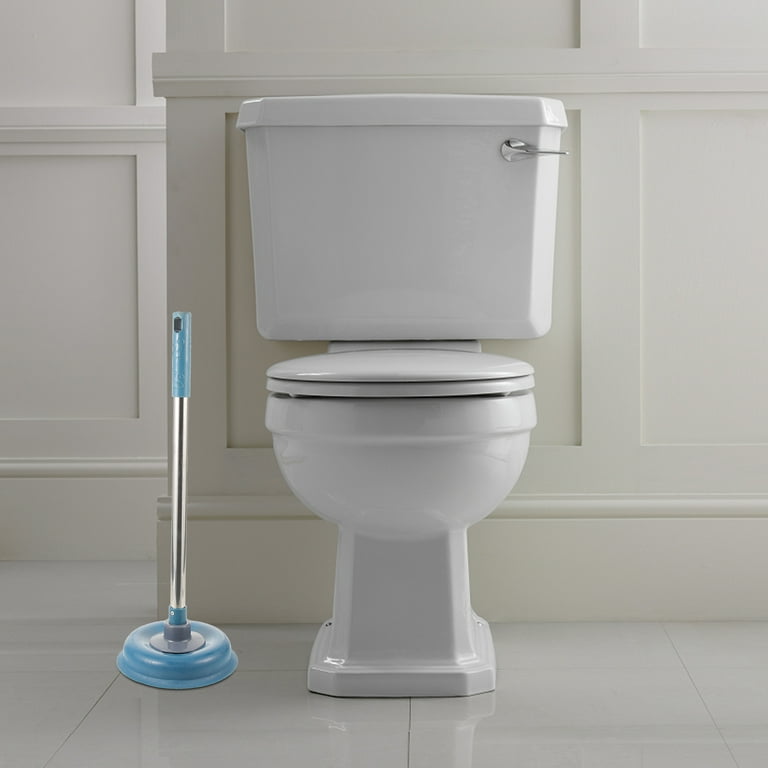We have stumbled on this article pertaining to How To Use Your Toilet Plunger Correctly in 5 Easy Steps down the page on the internet and decided it made perfect sense to talk about it with you over here.

Intro
Correct maintenance of house drains is crucial for avoiding clogs and ensuring smooth water flow. Among the trick devices in every house owner's toolkit is the bettor, together with various drainpipe cleansers created to deal with stubborn obstructions successfully. This short article explores just how to use bettors and drainpipe cleansers effectively to maintain your drains streaming openly.
Section 1: Understanding Plungers
Types of Plungers
There are a number of sorts of plungers readily available, each developed for various types of drains and obstructs. The most typical kinds include cup bettors, flange bettors, and accordion plungers.
Exactly How Plungers Job
Bettors deal with the concept of developing pressure and suction to remove blockages. When effectively applied over a drain, they produce a vacuum cleaner that can take out particles or separate clogs.
Choosing the Right Plunger
Selecting the right plunger depends on the type of drain and the nature of the clog. Cup plungers are perfect for sinks and tubs, while flange plungers are much better matched for commodes as a result of their style.
Typical Mistakes with Plungers
Staying clear of these blunders makes sure efficient plunging: incorrect seal around the drainpipe, not enough force, and not clearing bordering particles.
Section 2: Making Use Of Plungers Successfully
Preparation
Prior to plunging, ensure the bettor covers the drain entirely and develops a limited seal. Clear any type of visible debris around the drainpipe opening.
Strategy
Start with gentle diving movements to construct suction. Boost stress slowly, making use of a stable rhythm. Repeat as essential until the drainpipe gets rid of.
Repairing Tips
If diving doesn't work, attempt adjusting the seal, applying oil jelly for a better seal, or utilizing a various sort of plunger.
Section 3: Comprehending Drainpipe Cleaning Company
Sorts Of Drain Cleansers
Drain pipes cleaners can be chemical or enzymatic. Chemical cleaners utilize strong chemicals to dissolve clogs, while enzymatic cleansers use all-natural enzymes to break down raw material.
Just How Drain Cleaners Work
Chemical cleansers respond with obstructions to liquify them, while chemical cleaners break down organic materials like hair and oil without damaging pipelines.
Safety Considerations
Constantly use gloves and eye protection when making use of chemical drainpipe cleaners. Ensure ample air flow and follow manufacturer guidelines very carefully.
Eco-Friendly Alternatives
Consider making use of vinegar and baking soft drink or enzyme-based cleaners for eco-friendly alternatives that are safer for pipelines and the environment.
Section 4: Making Use Of Drain Cleaning Company Efficiently
Application Strategies
Pour chemical cleansers straight into the drainpipe opening. Permit them to work for the suggested time prior to purging with hot water. Enzymatic cleansers need to sit overnight.
Safety measures
Stay clear of blending different types of cleaners, as this can create poisonous fumes. Never ever make use of chemical cleaners along with a plunger, as splashing can happen.
Managing Stubborn Blockages
For consistent blockages, think about utilizing a pipes serpent or calling a specialist plumbing to prevent damage to pipes.
Final thought
Finally, comprehending how to utilize plungers and drainpipe cleansers successfully is important for maintaining healthy and balanced plumbing systems. By selecting the right devices and techniques, house owners can tackle minor blockages and prevent major pipes concerns down the line.
HOW TO USE A PLUNGER TO UNCLOG A TOILET, SINK OR TUB
You have a bad day at work. You get stuck in traffic for hours. You have a pounding headache. And there’s nothing to eat for dinner but leftovers. How can a day this bad get worse? Easy. You flush the toilet or pull the plug on a sink or tub…and the water goes nowhere.
General Plunger Tips:
- Make Sure You Use the Proper Plunger for the Job. All plungers are not created equal. There are basically two types — the cup plunger and the flange plunger. The classic cup type — probably the most familiar — is best for sinks, bathtubs and showers. The flange type has an extended rubber lip that provides a better seal for toilets.
- Keep The Plunger in Good Repair. Any tears of the cup or bell (the rubber part of the plunger) will result in a poor vacuum seal and loss of pressure. Plungers should be kept clean and dry when not in use to prevent cracking or ripping.
- Never Use a Plunger in Tandem with Drain Cleaning Chemicals. The plunging action will inevitably splatter dangerous chemicals onto your skin or clothing. Chemicals should only be used if a plunger fails to do the job.
- Remove Excess Water. Too much water in the tub, sink or toilet will make a mess when you start plunging. Use a bucket or siphon to remove water to the half-way point. But don’t entirely remove the water; if there’s no water, the cup won’t be able to form a vacuum seal and generate any pressure. There should always be enough water to submerge the cup. If there’s not enough water, fill a bucket from another source and add.
- Let Air Out of the Plunger Cup. A common mistake is to leave too much air in the plunger cup. Air, unlike water is compressible. If the cup is filled with air, it will compress every time you press down and act like a shock absorber. As a result, the clog won’t receive as much force. If the cup is filled with water, the force will be much more intense. Make sure you “burp” out the air from the cup and fill with as much water as you can before plunging.
- Get a Real Tight Seal. An easy way to improve the seal around the plunger is to add some petroleum jelly to the rim of the bell or cup. This will increase the suction. It will also prevent drying and cracking.
- Block All Other Outlets. If there is another sink or water fixture nearby, you’ll get better results if you block these drains before you start plunging. Get a wet cloth and stuff into these drains.
- Plunge with a Vertical Up-and-Down Action. Keeping the plunger handle straight and vertical, perpendicular with the base of the toilet, tub or sink is the best way to use a plunger. If you tilt at an angle, you won’t get proper force and the plunger seal can come loose.
How To Plunge a Clogged Sink, Tub or Shower:
- Use a STANDARD Cup Plunger.
- Securely Cover and Seal the Overflow Drain with a Wet Rag or Cloth.
- Submerge the Plunger Cup. Place the plunger over the drain and completely cover the drain opening.
- Push Down With Quick, Forceful Thrusts. This will concentrate pressure down the drain toward the obstruction. Repeat for 15-20 seconds.
How To Plunge a Clogged Toilet:
- Use the FLANGE type of plunger.
- If the bowl is full, put on some gloves and bail out until it is only half-full. If the bowl is empty, add water until it is half-full.
- Drape a towel over and around the toilet to catch any back-splash.
- Place the plunger in the bowl and completely cover the drain opening.
- Push Down With Quick, Forceful Thrusts. This will concentrate pressure down the drain toward the obstruction. Repeat for 15-20 seconds.
What if Plunging Fails to Unclog the Clog?
If plunging doesn’t remove the obstruction, you need to pursue more aggressive measures. While there are commercially available chemical drain cleaners and snake devices which can be quite effective at loosening the most stubborn of clogs, homeowners use these techniques at their own risk. Chemicals can burn and damage skin, clothing, pipes and surfaces. Snakes and other mechanical devices can actually compress and enlodge the obstruction more if used improperly.
Your best bet for plunger-resistant clogs is to call an experienced plumbing and drain cleaning professional who can quickly and safely remove the obstruction and get you back in the flow. Our team of emergency plumbers in Elkton, MD and other areas offer dependable drain cleaning services for homes. Our team has the tools necessary to unclog your sink, tub, or toilet. Give our team a call at 1-410-559-9527 to receive help with a clogged drain in your house.
https://www.horizonservices.com/about-us/blog/how-to-use-a-plunger-to-unclog-a-toilet-sink-or-tub/

I stumbled upon that review on How To Use Your Toilet Plunger Correctly in 5 Easy Steps while browsing on the web. Are you aware of another individual who is fascinated with Tips on How to Effectively Use a Plunger? Why not share it. We take joy in your readership.
Call Today
Comments on “How to Master Plungers and Drain Cleaner: Professional Guidance”